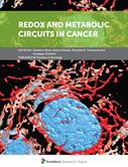Explore

Redox and Metabolic Circuits in Cancer
0 Ungluers have
Faved this Work
Login to Fave
Living cells require a constant supply of energy for the orchestration of a variety of biological processes in fluctuating environmental conditions. In heterotrophic organisms, energy mainly derives from the oxidation of carbohydrates and lipids, whose chemical bonds breakdown allows electrons to generate ATP and to provide reducing equivalents needed to restore the antioxidant systems and prevent from damage induced by reactive oxygen and nitric oxide (NO)-derived species (ROS and RNS). Studies of the last two decades have highlighted that cancer cells reprogram the metabolic circuitries in order to sustain their high growth rate, invade other tissues, and escape death. Therefore, this broad metabolic reorganization is mandatory for neoplastic growth, allowing the generation of adequate amounts of ATP and metabolites, as well as the optimization of redox homeostasis in the changeable environmental conditions of the tumor mass. Among these, ROS, as well as NO and RNS, which are produced at high extent in the tumor microenvironment or intracellularly, have been demonstrated acting as positive modulators of cell growth and frequently associated with malignant phenotype. Metabolic changes are also emerging as primary drivers of neoplastic onset and growth, and alterations of mitochondrial metabolism and homeostasis are emerging as pivotal in driving tumorigenesis.Targeting the metabolic rewiring, as well as affecting the balance between production and scavenging of ROS and NO-derived species, which underpin cancer growth, opens the possibility of finding selective and effective anti-neoplastic approaches, and new compounds affecting metabolic and/or redox adaptation of cancer cells are emerging as promising chemotherapeutic tools.In this Research Topic we have elaborated on all these aspects and provided our contribution to this increasingly growing field of research with new results, opinions and general overviews about the extraordinary plasticity of cancer cells to change metabolism and redox homeostasis in order to overcome the adverse conditions and sustain their “individualistic” behavior under a teleonomic viewpoint.
This book is included in DOAB.
Why read this book? Have your say.
You must be logged in to comment.
Rights Information
Are you the author or publisher of this work? If so, you can claim it as yours by registering as an Unglue.it rights holder.Downloads
This work has been downloaded 634 times via unglue.it ebook links.
- 182 - mobi (CC BY) at Unglue.it.
- 229 - epub (CC BY) at Unglue.it.
- 223 - pdf (CC BY) at Unglue.it.
Keywords
- Autophagy
- Bioenergetics
- Cancer Metabolism
- hypoxia
- medicine
- Mitochondria
- redox
- ROS
- S-nitrosylation
- Warburg effect
Links
DOI: 10.3389/978-2-88945-635-2Editions

